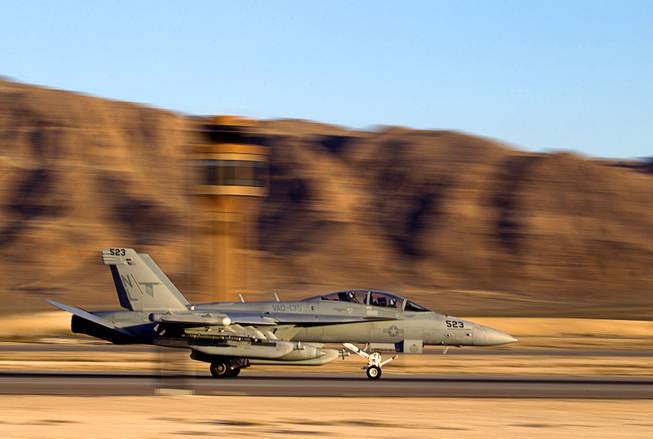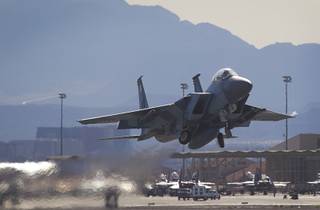
A U.S. Navy EA-18G Growler lands during Red Flag 13-3 media day at Nellis Air Force Base Wednesday, Feb. 26, 2013.
Saturday, March 9, 2013 | 2 a.m.
Sun coverage
Gary Giessow has given up hope that he’ll make the drive back to San Diego in time for dinner.
It’s nearing 5 p.m. Wednesday, and the jets are still swooping in to Nellis Air Force Base from their Red Flag mission that day. He meant to leave an hour ago, but the sun was on its descent, creating the perfect lighting to make the camouflaged jets pop against the gray clouds and blue sky.
He has spent the entire day on the gravel shoulder of Las Vegas Boulevard North outside Las Vegas Motor Speedway. He was there hunting for the perfect photos of the approaching aircraft.
His eyes transfixed on the horizon, Giessow spotted a formation of F-15 and F-16 jets swooping in for a landing. Armed with his Nikon 300D, it was another perfect photo opportunity.
“Bank it,” Giessow said with the excitement of a kid who has discovered a rare find in a pack of baseball cards. “Yes. Yes. Harder. No. Yes. Beautiful, he’s good for (me) here.”
Once again, time has escaped him. When he was younger, he often left his wife to go on two-week trips to go to air shows. Years later, the obsession still takes up his time — much to the dismay of his wife, he joked.
“It’s something I can’t explain,” Giessow, 74, said of his hobby. “Only people with a passion for something would understand.”
He is not alone in his passion. About 40 other people also are parked on the side of the road, scurrying from spot to spot to photograph the jets above. Many have made the pilgrimage from points far across the globe to Las Vegas specifically for Red Flag. For them, it’s one of the only times rare jets from around the world can be seen in one location.
For the military, Red Flag is a chance to give inexperienced airmen and command leaders from across the globe realistic mission training in a simulated war. It is the only place they can train with other countries and different branches of military for a war.
Soon, however, it could all be gone. As the automatic federal budget cuts tied to the sequestration begin to take effect and military spending is limited, future Red Flags could be grounded.
• • •
Far away from the aircraft enthusiasts and photographers outside Las Vegas Motor Speedway, the Red Flag war rages on at the Nevada Test and Training Facility.
B-2 bombers, fighter jets like the F-22 and F-16, and ground troops are deployed from Nellis Air Force Base to compete in the simulated war. Each of the aircraft is equipped with special sensors that allow a separate team to track them on a monitor and determine when a unit has been “killed.”
For 15 days, inexperienced airmen, analysts and other positions from bases across the United States and other ally countries work together as the Blue Force. They fight against the more-experienced Red Force, a squadron stationed on the testing ground meant to act like the enemy.
There are no winners or losers in Red Flag, said Lt. Col. Cameron Dadgar, deputy commander for the 414 Squadron in charge of the training exercise at Nellis. Instead, Red Flag is designed as a learning experience, allowing the airmen to grow from their mistakes rather than die in a real-life situation.
“The actual result is less important than the learning that takes place, that’s what it’s all about,” Dadgar said. “There is no scorecard, there are no wins or losses. … We want them to learn. That’s where the wins and losses happen.”
At this Red Flag, which began Feb. 25 and ends March 15, there are more than 3,500 military personnel participating. They come from all four branches of the U.S. military, as well as units from Great Britain’s Royal Air Force and the Australian Air Force.
The training integrates all four military branches and different countries to simulate how wars are fought today, Dadgar said. It gives participants a more realistic experience, which they can’t get on their own base, where there are limited resources.
“We come from Australia where we just don’t get the size and complexity of the training and adversaries that we get here,” said Australian Air Force wing commander Paul Carpenter. "For us, this is a fantastic opportunity to get our crews under stress, get them working harder than they ever thought they would … so they’re ready for a mission.”
Red Flag training began out of the necessity to provide inexperienced airmen with more realistic training after the Vietnam War. The United States had seen a drop in its airmen kill-to-death ratio, from 10-to-1 in the Korean Conflict to 2-to-1 in Vietnam.
A study investigating the drop, called the Red Baron Reports, discovered most airmen who died had less than 10 missions of experience.
Since Red Flag’s inception in 1975, more than 440,000 military personnel from 29 countries have participated in the exercise.
• • •
Giessow can still remember the first Red Flag in 1975. He was there taking photos with his analog film camera.
There was no Las Vegas Motor Speedway or fences blocking the field near the landing strip at Nellis. There were more types of aircraft those days, too. Giessow said he’d be the only one taking pictures.
Since then he has been to Red Flag about once every two years, watching it grow in popularity with the explosion of digital cameras.
There is something about the roar of the jets, the gracefulness with which they’re flown, and the chance to capture a rare aircraft that mesmerizes Giessow. It keeps him coming back time after time.
“There’s an elusiveness to getting a great shot or one that’s pleasing aesthetically,” Giessow said. “There’s also some nostalgia. Years later the pictures bring back (memories) of trips and what you did to get it.”
Giessow had plans to continue to return to Red Flag until he was no longer capable. Now, this might be his last one.
• • •
For now, the fate of Red Flag is unknown.
Until Nellis is notified that Red Flag has been cut as part of the Defense Department’s budget cuts to meet sequestration guidelines, preparation for Red Flag will continue as normal.
“Due to the amount of planning and effort involved in each Red Flag exercise, we must be ready to execute as required,” Dadgar wrote in an email. “Therefore planning will continue.”
Yet with a 10 percent cut to defense spending, the future of the Red Flag exercise could be in danger. The fate of July’s Red Flag won’t be known until cuts take effect at the end of March.
Maj. Christopher Keown of the 526th Intelligence Squadron said the loss of the training program would have drastic effects on the U.S. military.
“It degrades your ability to go to war,” Keown said. “You fight with who and what you know. If you were to step to the next fight and all you did was train in your own little station, own little box, you won’t be able to integrate.”
“Everybody comes out here — we’re very good individually — but it is that integration piece, and the way you do better at war is to integrate.”
Giessow said he’d miss Red Flag if it were to end. Yet on this sunny Wednesday afternoon, he is not thinking of endgame scenarios. The aircraft still are returning from their mission, and he’s having too much fun.
His only worry is if he’ll make it back to San Diego before midnight.


Join the Discussion:
Check this out for a full explanation of our conversion to the LiveFyre commenting system and instructions on how to sign up for an account.
Full comments policy